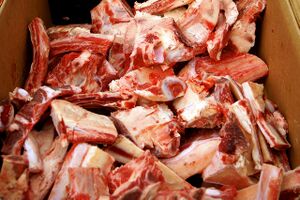Bones
From Cookipedia
Bones are the major ingredient of stocks (except water, of course). Most of the flavour and body of stocks are derived from the bones of beef, veal, chicken, fish, and, occasionally, lamb, pork, ham, and game. (Vegetable stocks, an exception, draw their flavour entirely from vegetables.) The kinds of bones used determine the kind of stock.
- Chicken stock, of course, is made from chicken bones.
- White stock is made from beef or veal bones, or a combination of the two. Chicken bones or even pork bones are sometimes added in small quantities.
- Brown stock is made from beef or veal bones that have been browned in an oven.
- Fish stock is made from fish bones and trimmings left over after filleting. Bones from lean white fish give the best stock. Oily fish are not normally used. The term fumet is often used for a flavourful fish stock, especially one made with wine.
- Lamb, game, turkey, and other stocks have specialised uses.

Some of the proteins known as connective tissue are dissolved when cooked with slow, moist heat.
- When certain connective tissues (called collagen) break down, they form gelatin. This gives body to a stock, an important feature of its quality. A well-made stock thickens or even solidifies when chilled.
- Cartilage is the best source of gelatin in bones. Younger animals have lots of cartilage in their skeletons. As they become older, this hardens into solid bone, which is harder to dissolve into stocks. Knuckle bones, on the joints of major bones, have a lot of cartilage and are valued in stock-making. Neck bones and shank bones are also used a great deal.
Cut large bones into pieces about 8cm long. This exposes more surface area and aids extraction. Also, the bones are easier to handle.